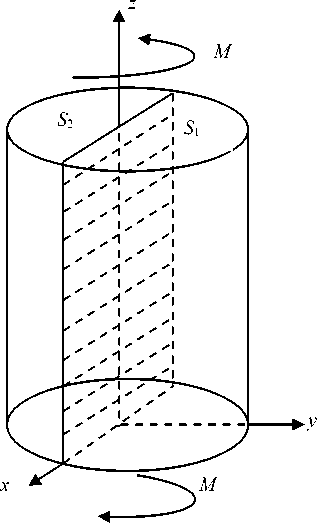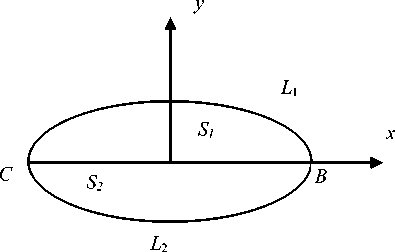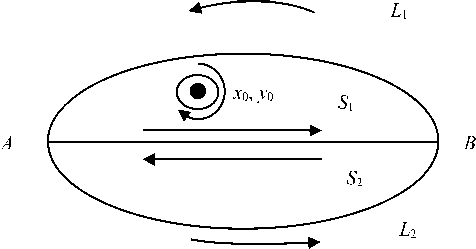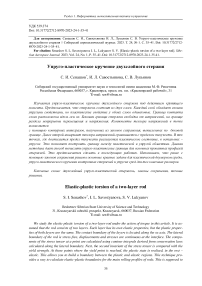Elastic-plastic torsion of a two-layer rod
Автор: Senashov S.I., Savostyanova I.L., Lukyanov S.V.
Журнал: Siberian Aerospace Journal @vestnik-sibsau-en
Рубрика: Informatics, computer technology and management
Статья в выпуске: 1 vol.24, 2023 года.
Бесплатный доступ
We study the elastic-plastic torsion of a two-layer rod under the action of torque in this article. It is as-sumed that the rod consists of two layers. Each layer has its own elastic properties, but the plastic proper-ties of both layers are the same. The contact boundary of the layers is located along the ох axis. The lateral boundary of the rod is stress-free, displacements and stresses are continuous at the interface. The compo-nents of the stress tensor at a point are calculated using contour integrals derived from conservation laws calculated along the lateral boundary. Next, the second invariant of the stress tensor is compared with the yield strength. At those points where the yield point is reached, the plastic state is realized, in the rest – elastic. This allows you to build a boundary between the plastic and elastic regions. This technique pro-vides a way to calculate elastic-plastic boundaries for the main rolling profiles of rods. This is supposed to be done in subsequent works. We remind you that earlier, with the help of conservation laws, the main boundary value problems for a plastic two-dimensional medium, elastic-plastic torsion of isotropic rods and elastic media for bodies of finite dimensions were solved.
Two-layer elastic-plastic rod, conservation laws, exact solutions
Короткий адрес: https://sciup.org/148329672
IDR: 148329672 | УДК: 539.374 | DOI: 10.31772/2712-8970-2023-24-1-35-41
Текст научной статьи Elastic-plastic torsion of a two-layer rod
The article continues a series of papers devoted to the use of conservation laws for solving boundary-value problems of the equations of mechanics of a deformable solid body. The equations of elasticity and plasticity have been studied for long with the help of symmetries [1; 2]. Further, it was shown that conservation laws can be used and they were used to solve boundary-value problems for twodimensional plasticity equations [3–12]. These works have shown that conservation laws are more suitable for solving boundary-value problems than point symmetries, which were previously counted on [2]. This is explained by the fact that symmetries are local in nature, unlike conservation laws, they are global in nature. Further, conservation laws were applied to solve elastic-plastic problems of rod torsion and cantilever bending, as well as to solve elastic-plastic problems for finite-size plates weakened by holes [13–18]. In this paper, we show that conservation laws can also be used to solve boundary-value problems for multilayer materials.
Statement of problem
Let us consider a straight rod, the cross section of which is shown in Fig. 1. Let the areas S and S be occupied by elastic-plastic isotropic materials, in which the yield strength in pure shear is the same and it is equal to k ; the Lame elastic constants are different and equal to λ , µ and λ , µ respectively. Let the dividing line of materials be straight. We choose ох coordinate axis along the dividing line. As usual, it is assumed that the lateral face of the rod is stress-free, and the rod is twisted by a pair of forces with the moment
M = ∫∫ ( y σ 13 - x σ 23) dxdy .


Рис. 1. Кручение двухслойного стержня
Fig. 1. Twisting of a two-layer rod
In this case the equations describing the stress state in the S i = 1,2 area have the following form
F 1 = ∂ x σ 13 + ∂ y σ 23 = 0, F 2 = ∂ y σ 13 -∂ x σ 23 +µ i ω= 0, µ i ω= Ki , (1)
where σ , σ – stress components, ω – twist angle (it is assumed to be constant).
On the lateral face of the rod the following conditions are satisfied
σ13n1 + σ23n2 = 0, σ + σ = k , which mean that the lateral face is free from stress and is in a plastic state.
From (2) we obtain
σ 13 = kn 1 , σ 23 = - kn 2 .
We also assume that the components of the stress tensor are continuous at the CD boundary, which means that there is no stress discontinuity for this rod along the CD boundary.
Conservation laws
We are searching for the conservation law in the following form
A x + B y =ρ 1 F 1 +ρ 2 F 2 , (4)
where ρ , ρ are some functions that are simultaneously not identically equal to zero; the lower indexes mean derivatives with respect to the corresponding variables.
Comment. More detailed information about conservation laws, their calculation and use can be found in the literature cited above.
Let
A = α1u + α2v+α3, B = β1u + β2v+ β3,(5)
where for convinience we assumed σ = u,σ = v, α1,α2,α3, β1,β2,β3 to be the functions only of x,y.
Substituting (5) into (4) we obtain 122112 12 3 3 2
α = β , α = -β , αx- α y= 0, α y+ αx= 0, αx + β y = -α
Let
α1(i)-α2(i)=0, α1(i)+α2(i)=0, α3(i0+β3(i0=-α2K, i=1,2
xy yx xyi
The index i in parentheses corresponds to the Si area.
Let us suppose that at the x 0 , y 0 point the subintegral functions have a singularity and this point is in a circle of the radius ε :( x - x 0)2 + ( y - y 0)2 = ε 2 (Fig. 2), then from (4) we obtain
∫∫ ( Ax + By ) dxdy = ∫∫ ( A 1 x + B 1 y ) dxdy + ∫∫ ( A 2 x + B 2 y ) dxdy = - ∫ A 1 dy - B 1 dx +
S S 1 S 2 ε
+
∫ A 1 dy - B 1 dx + ∫ A 2 dy - B 2 dx + ∫ A 1 dy - B 1 dx + ∫ A 2 dy - B 2 dx = 0
L 1 L 2
CD DC
We have along CD
∫ A 1 dy - B 1 dx + ∫ A 2 dy - B 2 dx = ∫ ( α 1(1) u + α 2(1) v + α 3(1)) dy - ( -α 2(1) u + α 1(1) v + β 3(1)) dx + CD DC CD
+ ∫ ( α 1(2) u + α 2(2) v + α 3(2)) dy - ( -α 2(2) u + α 1(2) v + β 3(2)) dx = 0
DC

Рис. 2. Схема взятия интегралов по поперечному сечению
Fig. 2. The scheme of taking integrals over the cross section
Since along the CD dy = 0, we assume that P 3( i ) = 0, a 3( i ) = a 2 ( i ) K , therefore a 1(1 ) = a 1(2), a 2(1 ) =a 2(2).
As a result we obtain j A1 dy - B1 dx = j A1 dy - B dx + J A2 dy - B2 dx.
£ L1
We use the formula (8) to find the functions u , v at the point
In order to do that, let us consider the solution to the equations (7) in the following form
1 x - xn 2 y — У о 3 x - Хл a =-------5---0------y, a =------0------a = wg1arctg----0.(9)
( x - x o ) + ( y - y 0 ) ( x - x 0 ) + ( y - y 0 ) y - y 0
Substituting (9) into (8) we obtain j A1 dy - B1 dx = j (a1u + a2v + a3)dy - (-a2u + a1 v)dx = ££ x xо
. ( x - x о ) 2 + ( y - y о ) 2
u
-
y - y 0
( x - x 0 )2 + ( y - y 0 )2
x-x v Iw^arctg----0- y - У о J
dy
-
y - y
[ ( x - x о ) 2 + ( y - y о ) 2
Л u dx +
J
+ j
£
Let x - x 0 =£ cos ф , y - y 0 =£ sin ф .
Then we obtain
2 n
x - x 0
( x - x 0 )2 + ( y - y 0 )2
v dx
2 n
j A1 dy - B1 dx = j [( u cos p + v sin ^ )cos p + ( u sin (p + v cos ^ )sin p ] d p = j ud p = 2 n u ( x 0, y 0).
£
The last equality uses the mean value theorem and the passage to the limit £ ^ 0.
As a result, from the formula (8) it follows
2 n^ 13( x о , У o ) =
j
L 1 <
x - x 0
y - y 0
( x - x o ) + ( y - y o ) ( x - x 0 ) + ( y - y 0 )
, x = xn kn 2 +w^1arctg----0
У - У o
dy -
—
---4^--- I kn
( x — x o ) + ( У — У o )
—
x — x0 ,,
------- ---o------- kn 2
(x — x o) + (У — У o)
+ f
L 2 <
x — x o
y — y 0
( x — x o ) + ( У — У o ) ( x — x o ) + ( У — У o )
, x = xn kn 2 + wg2arctg----0
У — У o
dy —
---У^---У kn —
( x — x o ) + ( У — У o )
x — x 0
( x — x o ) 2 + ( У — y o )2
kn 2
J
dx .
Let us consider the solution to the equations (7) in the form a1 =------У—^o------, a2
( x — x o) + ( У — У o)
x — x 0
( x — x o)2 + ( У — У o)2
a 3 = 1 ®H 2 ln(( x — x 0 ) 2 + ( У — У o)2) .
Substituting (11) into (8) we obtain
2 п^ 2з ( x o , У o ) =
f (—F ^--kn i
L ( x — x o ) + ( У — У o )
—
------T x—x o------Г kn 2 + 1 ®^ 2 ln(( x — x o )2 + ( У — У o )2 ) d —
( x — x o )2 + ( У — У o )2 2
— (-- x—x -----У kn 1 +------ У— У o----- - kn 2) dx +
( x — x o ) + ( У — У o ) ( x — x o ) + ( У — У o ) (12)
+ f (-- У — ^o----- kn i +
L ( x — x o ) + ( У — У o )
x — x o
( x — x o )2 + ( У — У o )2
kn 2 + 1 ®^ 2 ln(( x — x o )2 + ( У — У o )2 )& —
— (-- x—x -----y kn 1 +------ У— У o----- - kn 2) dx .
( x — x o ) + ( У — У o ) ( x — x o ) + ( У — У o )
Conclusion
The formulae (10), (12) allow us to calculate the values of the stress tensor components at all points of the cross section. Further in each point of x0, y0 the plasticity condition is checked. The points where belong to the elastic zone, and all the other points – to the plastic one. Thus, the described procedure makes it possible to identify plastic and elastic zones and construct an elastic-plastic boundary, which was unknown in advance and had to be determined.
Список литературы Elastic-plastic torsion of a two-layer rod
- Annin B. D., Bytev V. O., Senashov S. I. Gruppovye svojstva uravnenij uprugosti i plastichnosti [Group properties of elasticity and plasticity equations]. Novosibirsk. Nauka. 1985. 144 p.
- Ovsyannikov L. V. Gruppovoj analiz differencial'nyh uravnenij [Group analysis of differential equations]. Moscow. Nauka. 1978. 399 p.
- Senashov S. I. On the laws of conservation of plasticity equations. Doklady AN SSSR. 1991. vol. 320. №. 3. p. 606.
- Senashov S. I. [Conservation laws and the exact solution of the Cauchy problem for plasticity equations] Doklady RAN. 1995. vol. 345. №. 5. p. 619.
- Kiryakov P. P., Senashov S. I., Yakhno A. N. Prilozhenie simmetrij i zakonov sohraneniya k resheniyu differencial'nyh uravnenij [Application of symmetries and conservation laws to the solution of differential equations]. Novosibirsk. SO RAN. 2001. 201 p.
- Senashov S. I., Vinogradov A. M. Symmetries and conservation laws of 2-dimensional ideal plasticity. Proc. Edinburg Math. Soc. 1988. pp. 415–439.
- Senashov S. I., Yakchno A. N. Reproduction of solutions for bidimensional ideal plasticity. Journal of Non-Linear Mechanics. 2007, Vol. 42, P. 500–503.
- Senashov S. I., Yakchno A. N. Deformation of characteristic curves of the plane ideal plasticity equations by point symmetries. Nonlinear analysis. 2009, No. 71, P. 1274–1284.
- Senashov S. I., Yakchno A. N. Conservation Laws, Hodograph Transformation and Boundary Value Problems of Plane Plasticity. SIGMA. 2012, Vol. 8, No. 071, P. 16.
- Senashov S. I., Yakchno A. N. Some symmetry group aspects of a perfect plane plasticity sys-tem. J. Phys. A: Math. Theor. 2013. No. 46, P. 355202.
- Senashov S. I., Yakchno A. N. Conservation Laws of Three-Dimensional Perfect Plasticity Equations under von Mises Yield Criterion. Abstract and Applied Analysis. 2013, Vol. 2013, 8 p.
- Gomonova O. V., Senashov S. I. Determination of elastic and plastic deformation regions in the problem of uniaxial stretching of a plate weakened by holes. Journal PMTF. 2021, Vol. 62, No 1.
- Senashov S. I., Filyushina E. V. [Conservation laws of the equations of the plane theory of elasticity]. Vestnik SibGAU. 2014, No. 1 (53), P. 79–81 (In Russ.).
- Senashov S. I., Savostyanova I. L. On elastic torsion around three axes. Siberian Journal of Industrial Mathematics. 2021, Vol. 24, No. 1, P. 120–125 (In Russ.).
- Senashov S. I., Gomonova O. V. Construction of Elastoplastic Boundary in Problem of Ten-sion of a Plate Weakened by Holes. Intern. J. Non. Lin. Mech. 2019, Vol. 108, P. 7–10.
- Gomonova O. V., Senashov S. I. Determination of elastic and plastic deformation regions in the problem of uniaxial tension of a plate weakened by holes. Journal of Applied Mechanics and Technical Physics. 2021, Vol. 62, No. 1, P. 179–186.
- Senashov S. I., Kondrin A. V.; Cherepanova, O. N. On Elastoplastic Torsion of a Rod with Multiply Connected Cross-Section. J. Siberian Federal Univ., Math. & Physics. 2015, No. 7(1), P. 343–351 (In Russ.).
- Senashov S. I., Cherepanova О. N., Коndrin А. V. Elastoplastic Bending of Beam. J. Siberian Federal Univ., Math. & Physics. 2014, No. 7(2), P. 203–208 (In Russ.).


